10 Beautiful Black Chicken Breeds (With Pictures)
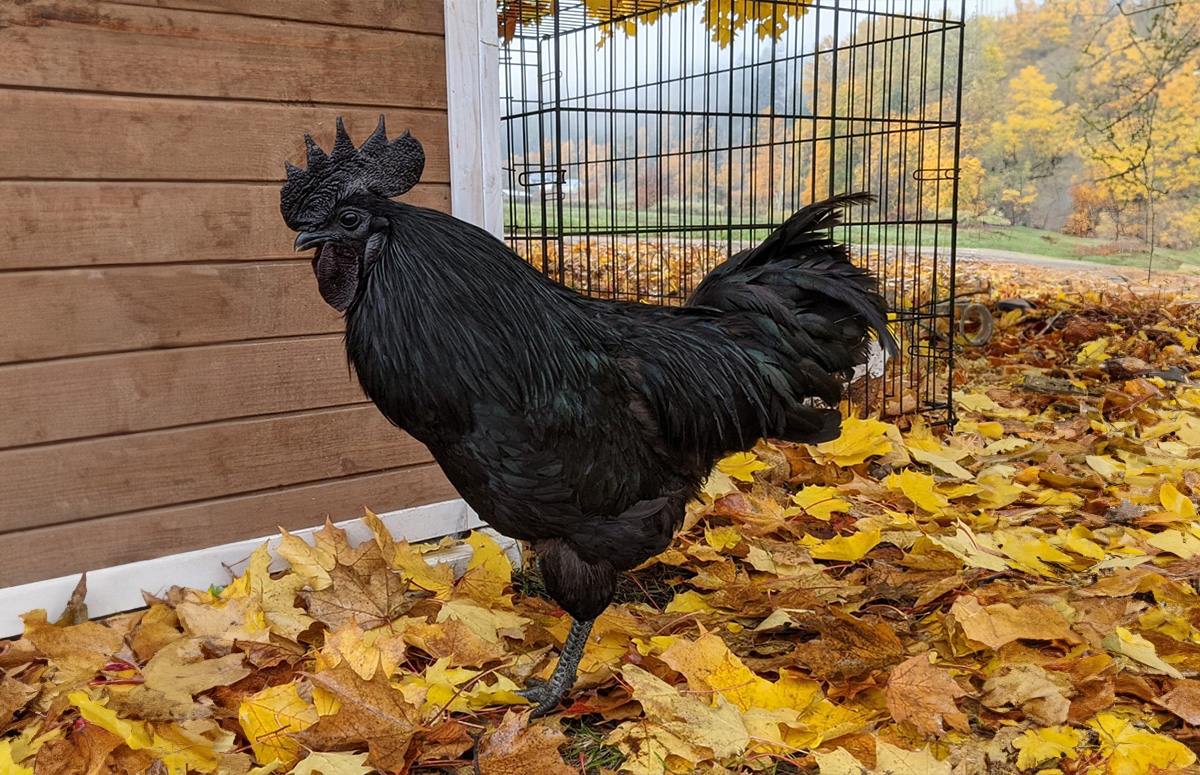
While brown and white remain the most favored colors for chickens, black is gaining popularity. Black chickens look mysterious and easily draw the attention of many poultry enthusiasts.
However, not all black breeds are suitable for every backyard chicken owner. Let’s review the most wanted black chicken breeds and why (not) to buy them.
- Ayam Cemani
- Mystic Onyx
- Fibro Easter Egger
- Kadaknath
- Swedish Black Hen
- Australorp
- Jersey Giant
- White Faced Black Spanish
- Black Silkie
- Black Araucana
1. Ayam Cemani
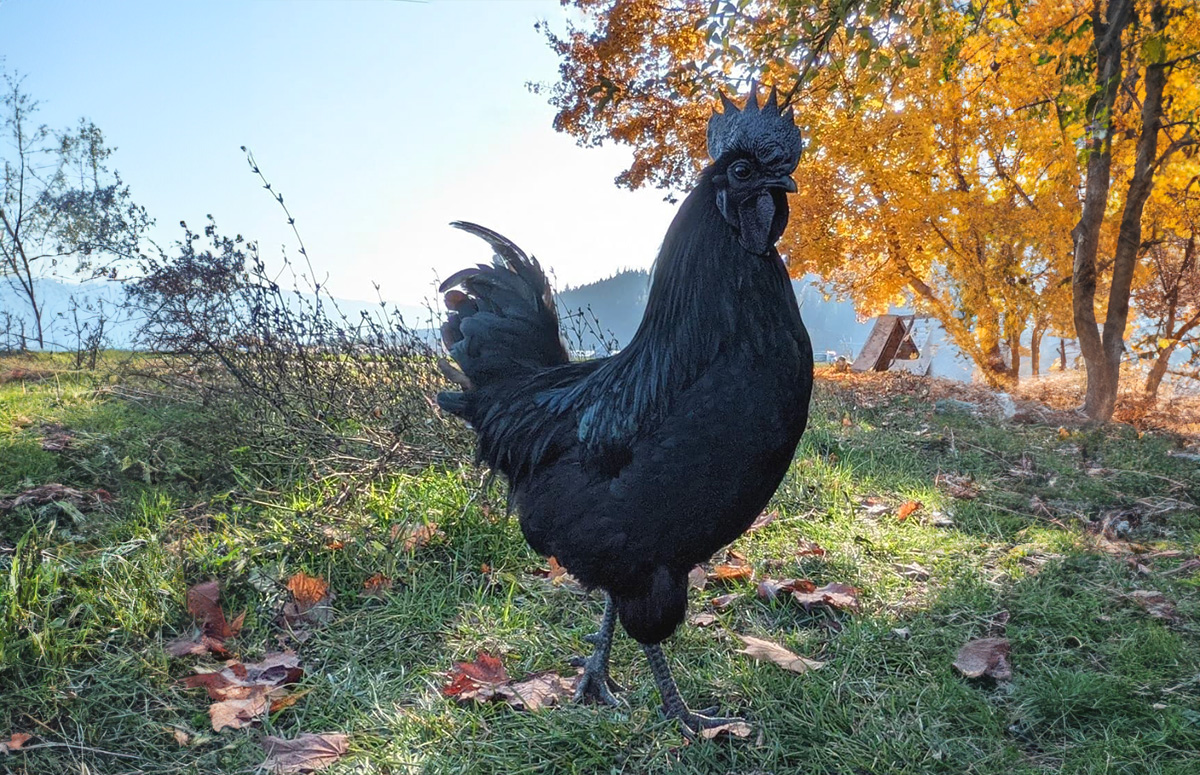
Adding an Ayam Cemani to your flock would bring a deep black chicken superstar into your collection. The breathtaking appearance of Ayam Cemani chickens makes them the most expensive chicken breed in the world.
Some people refer to the Ayam Cemani as the ‘Lamborgini in poultry’, and they’re not wrong! With its black color from head to toe, high price, and rareness, the Ayam Cemani is one of the most mysterious chicken breeds in the world.
| Eggs | Between 60 – 100 eggs per year |
| Egg Color | Tinted |
| Egg Size | Small |
| Weight | 3.5 – 5 lbs |
| Hardiness | Cold & heat |
| Temperament | Docile and friendly |
| Beginner-friendly | Yes |
| Color | Black |
The price of unsexed chicks can range from $70 to an astonishing $2500, depending on the ancestors of the chick.
The mutation that is responsible for its dark color from head to toe is called fibromelanosis (fibro). Everything in this breed is black: its organs, bones, skin, feet, beak, tongue, wattles, comb, and feathers.
Apart from the high price, one major disadvantage of an Ayam Cemani is that they are not the best egg-layers. They lay between 60 and 100 eggs yearly, significantly less than most other breeds. The eggs are also small in size.
An Ayam Cemani does not lay black eggs, all eggs are cream-colored.
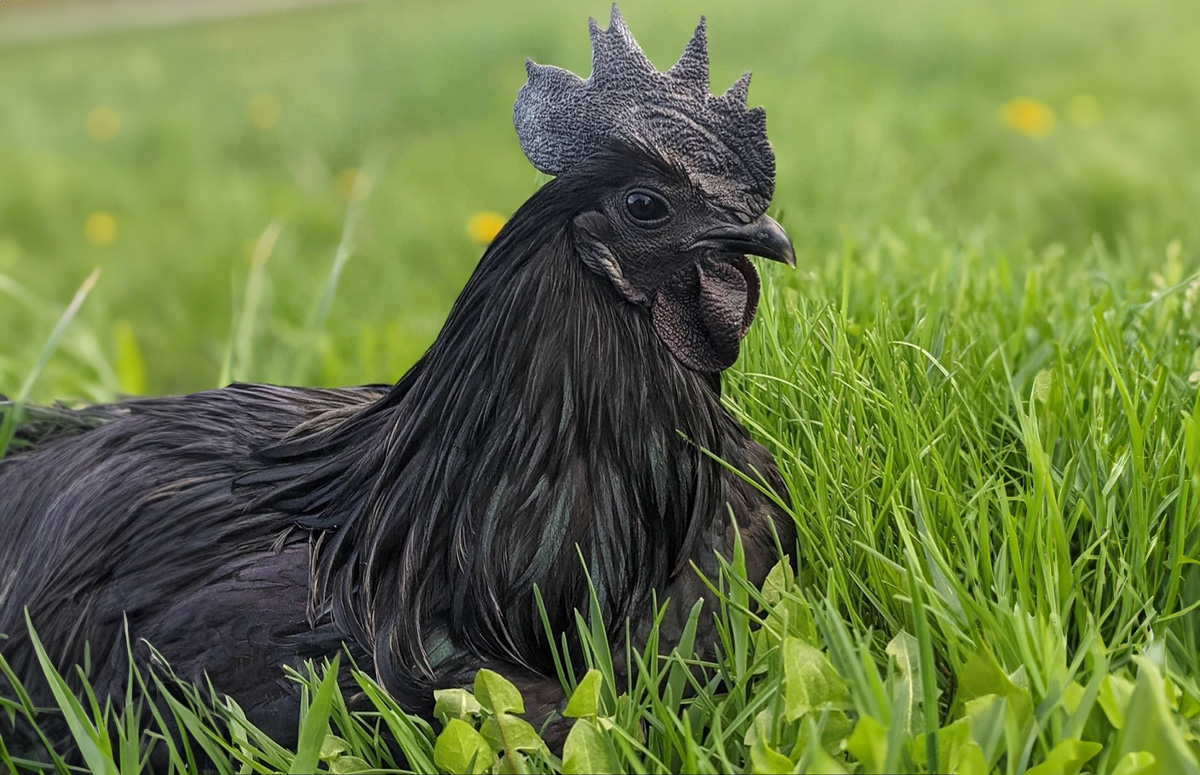
Ayam Cemani chickens are a hardy breed that can thrive in many climates. Additionally, they are a healthy breed that requires minimal care; they only need water, food, and shelter. As a result, they are an excellent option for beginners and are easy to care for.
If you don’t want to spend the $ on an Ayam Cemani, check out numbers two and three on our black beauty list!
2. Mystic Onyx
Mystic Onyx chickens are not a real breed; they’re a hatchery mix of Silkies and a larger meat bird to create an attractive dark-colored chicken that looks a lot like the Ayam Cemani for a fraction of the price.
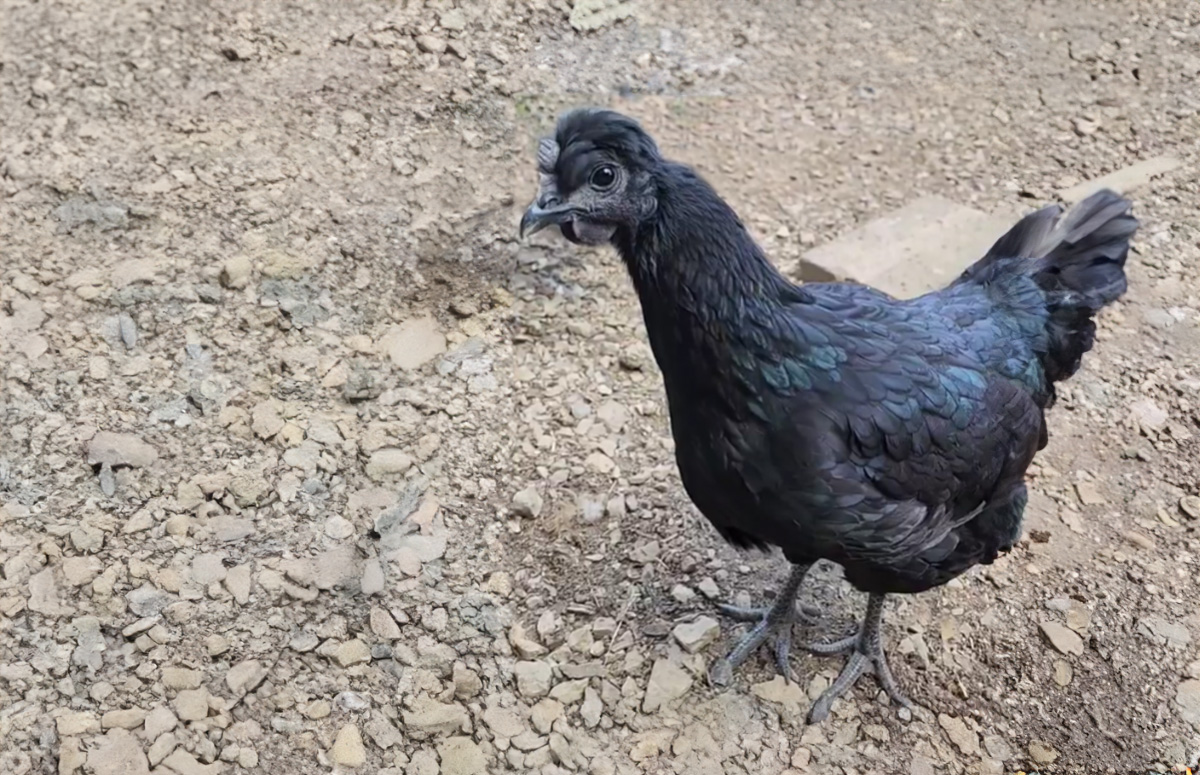
However, Mystic Onyx chickens are not as dark as an Ayam Cemani; some have orange flares in their feathers. But their skin is also black, making them an ideal breed for those wanting a beautiful black chicken without paying as much.
| Eggs | 220 eggs per year |
| Egg Color | Light brown |
| Egg Size | Medium |
| Weight | 5 – 6 lbs |
| Hardiness | Cold and heat |
| Temperament | Friendly, energetic |
| Beginner-friendly | Yes |
| Color | Black with little orange flares |
They’re good layers and lay up to 220 light brown eggs annually. All eggs are medium-sized. They reach sexual adulthood around 20 weeks old and start laying around the same time.
These birds are cold-hardy, so they’ll keep laying during winter. However, egg production can slow down. They’re excellent laying hens giving you a year-round egg supply, except during molting.
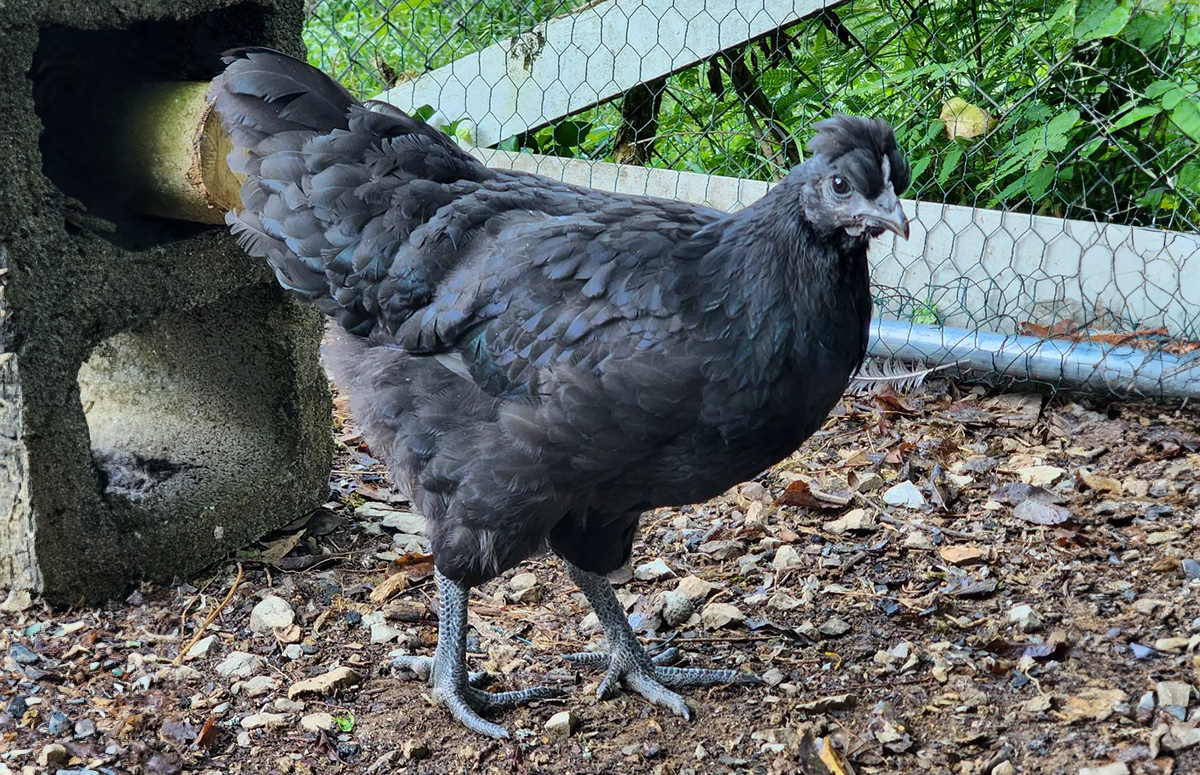
Although Mystic Onyx chickens remain unknown to the large public (until now), they are a beginner-friendly breed. They are a great addition to your backyard flock, whether you are new to chicken keeping or not.
Another example of a black hatchery mix is a black sex-linked Marans, like the Midnight Majesty Marans, that lays dark brown eggs.
3. Fibro Easter Egger
This completely black-colored variety of the Easter Egger has all it takes to conquer the world. Just like Silkies, Ayam Cemani and Mystic Onyx, the Fibro Easter Egger is part of a special group of chickens with Fibromelanosis, which causes hyper melanin or hyperpigmentation.
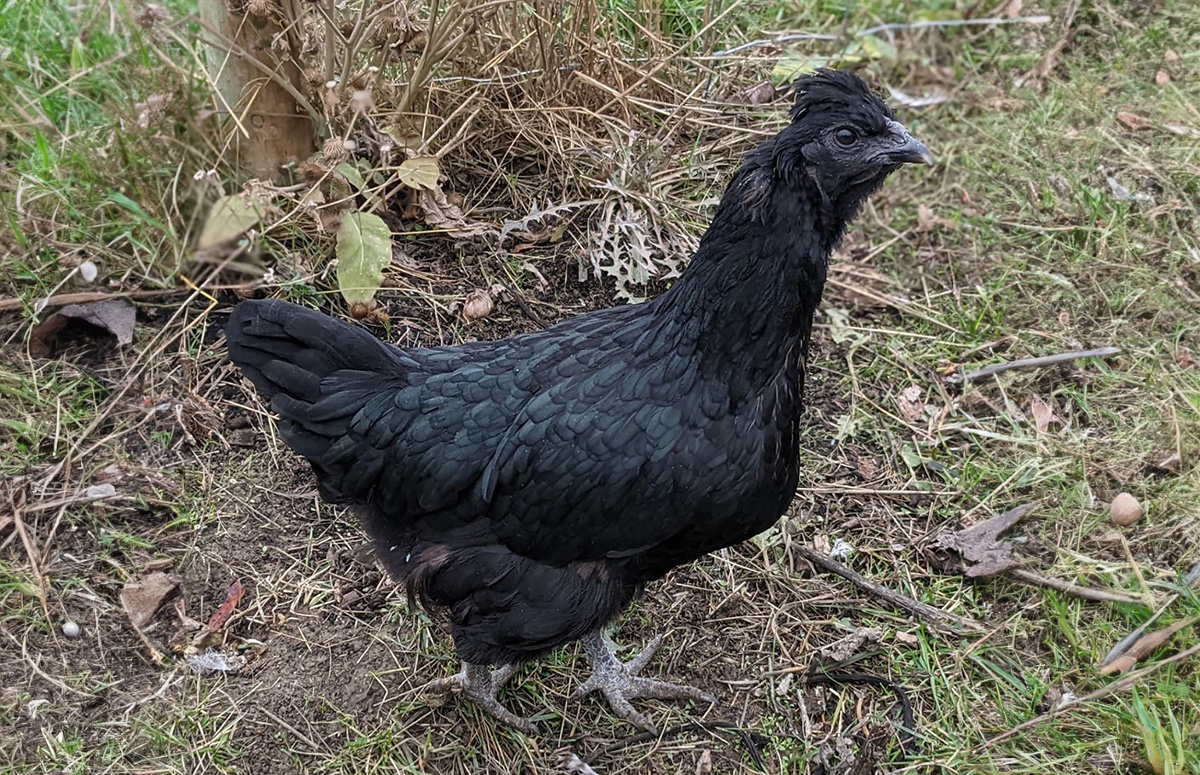
Black chickens are getting increasingly popular, so hatcheries become more innovative in developing affordable breeds that possess black features similar to the Ayam Cemani.
The Fibro Easter Egger is a hybrid chicken, a designer breed created to look a certain way and bring many beautifully colored eggs.
| Eggs | 220 eggs per year |
| Egg Color | Blue, green, brown, pink |
| Egg Size | Medium |
| Weight | 5 – 6 lbs |
| Hardiness | Cold and heat |
| Temperament | Friendly and calm |
| Beginner-friendly | Yes |
| Color | Black with secondary colors |
The Fibro Easter Egger is found exclusively at Meyer Hatchery. They created this hybrid chicken and added it to their chick catalog for the first time in 2022.
The hatchery does not state which breeds have been used to create this unique-looking bird.
The Fibro Easter Egger is an excellent egg layer, producing 4-5 eggs per week. The egg size is considered large, and they typically begin laying at 24 weeks of age.
What’s even more exciting is the range of colors they lay. Their eggs can be olive green, turquoise blue, or even occasionally rose or brown, making each egg a unique and colorful addition to any basket.
4. Kadaknath
The Kadaknath chicken, also known as Kali Masi (which translates to ‘fowl having black flesh’), is an rare breed from India. Its striking black coloration is also a result of fibromelanosis, a condition also seen in the previous breeds in this article. It also leads to its black flesh, bones, and organs.
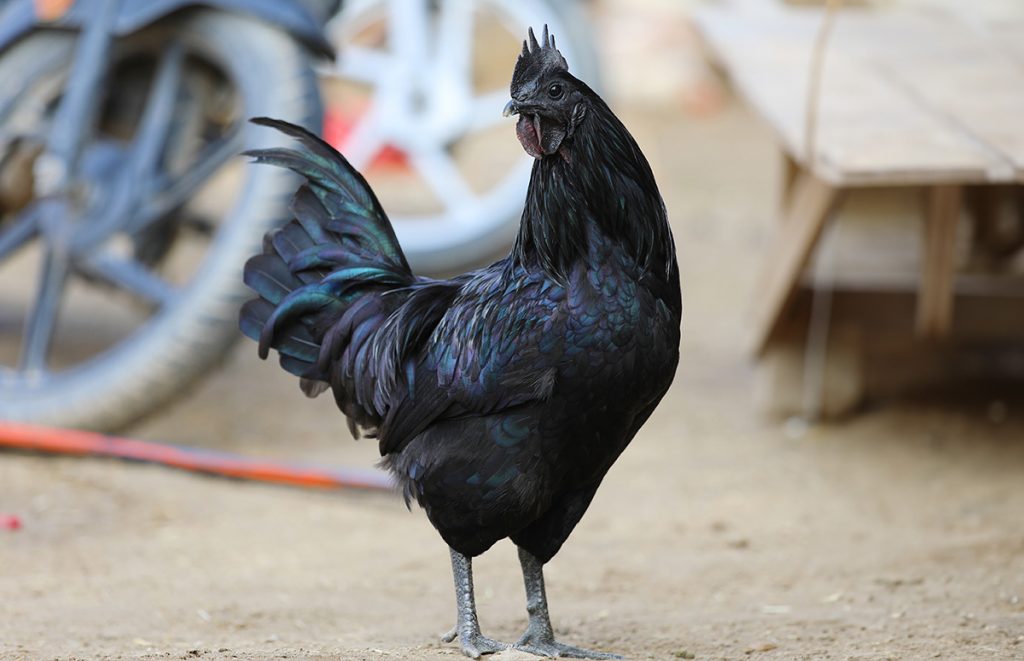
Some birds also exhibit gold plumage with a greenish iridescence, adding to their unique appearance.
| Eggs | 80 eggs per year |
| Egg Color | Brown with pink tint |
| Egg Size | Small |
| Weight | 2.5 – 4 lbs |
| Hardiness | Cold and heat |
| Temperament | Friendly and calm |
| Beginner-friendly | Yes |
| Color | Black with green sheen |
Originating from the Kathiwar Alirajapur jungles, the Kadaknath is known to adapt well to different conditions. Their unique black-grey meat is believed to give energy and strength to those who eat it.
Kadaknath hens lay small brown eggs with a pink tint, but are poor setters, rarely hatching their own eggs. They lay around 80 eggs per year.
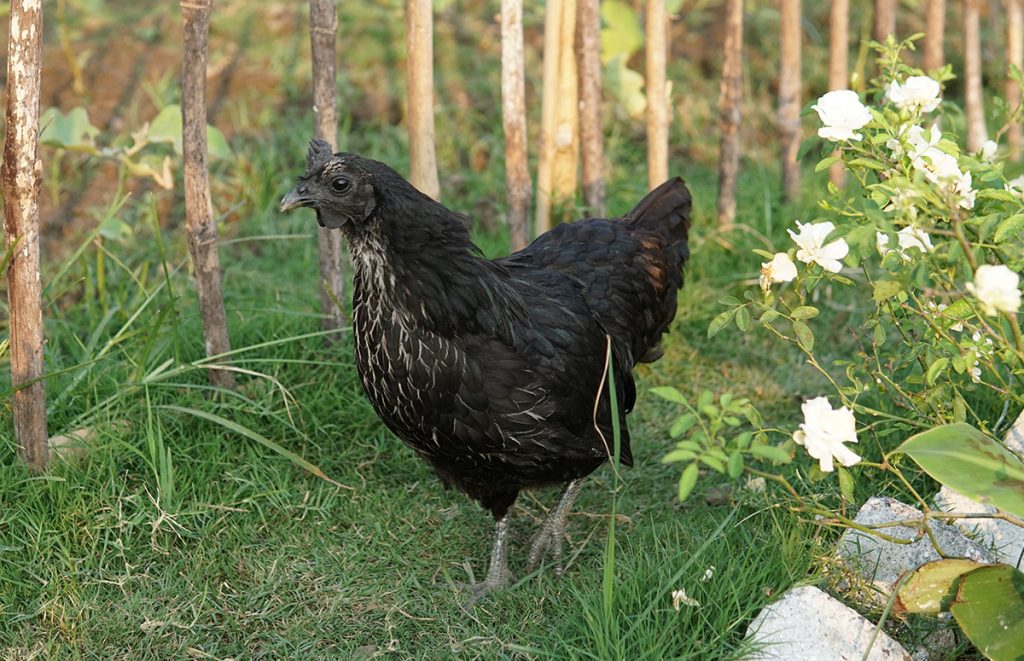
Despite its fascinating features, Kadaknath faces a threat of extinction due to high consumption. To counter this, the state government started a conservation breeding program.
Additionally, the breed has been subjected to scams due to its popularity and limited availability, affecting both farmers and consumers.
5. Swedish Black Hen
The Swedish Black Chicken, also known as Svarthöna, Svart Hona, or Bohuslän-Dals svarthöna, is a Swedish landrace. Its lineage traces back to the Ayam Cemani and Kadaknath breeds brought from Mozambique to Norway by sailors in the 17th century.
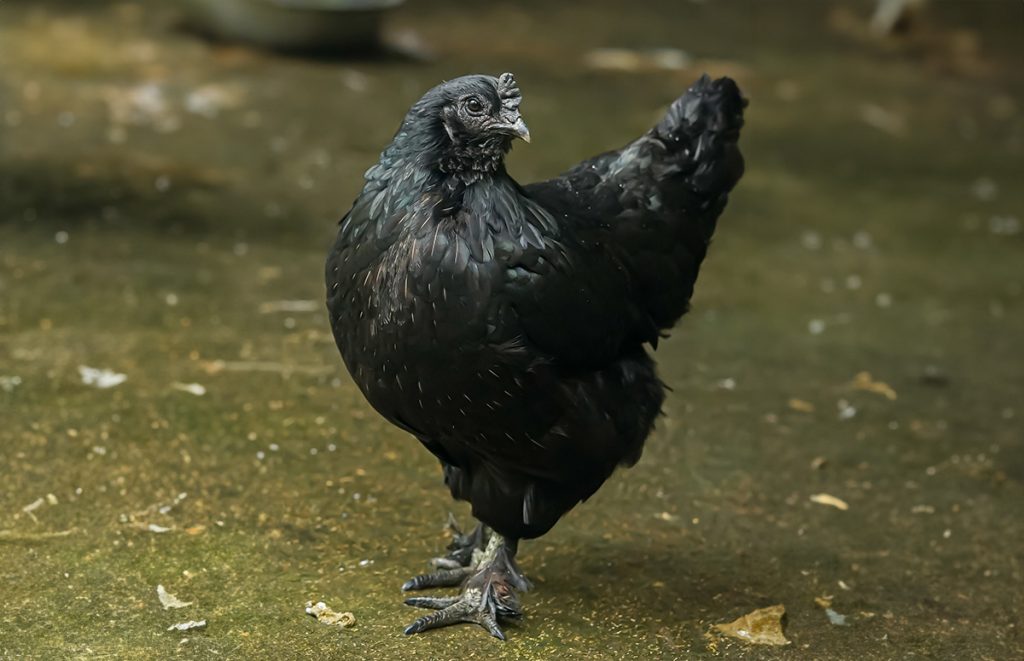
Over time, the Svarthöna has adapted to the colder climate of Northern Europe, while retaining its unique characteristic of black skin and connective tissue.
Svarthöna chickens are relatively small. Roosters weigh up to 4.5 lbs, while hens usually do not exceed 3.5 lbs.
| Eggs | 180 eggs per year |
| Egg Color | Cream |
| Egg Size | Small |
| Weight | 3.5 – 4.5 lbs |
| Hardiness | Cold and heat |
| Temperament | Friendly and calm |
| Beginner-friendly | Yes |
| Color | Black |
Their eggs are small, weighing around 38-48 g, with a proportionally large yolk. The hens lay around 180 cream-colored eggs per year.
Additionally, these chickens possess some ability to fly, distinguishing them from many other domesticated breeds.
The black pigmentation of the Svarthöna is due to a variant of the gene EDN3. This genetic trait is shared with other poultry breeds, including the Silkie, Ayam Cemani, and Black H’Mong.
6. Australorp
Australorp chickens are an Australian chicken breed. They are large chickens but very friendly and docile, suited for beginners.
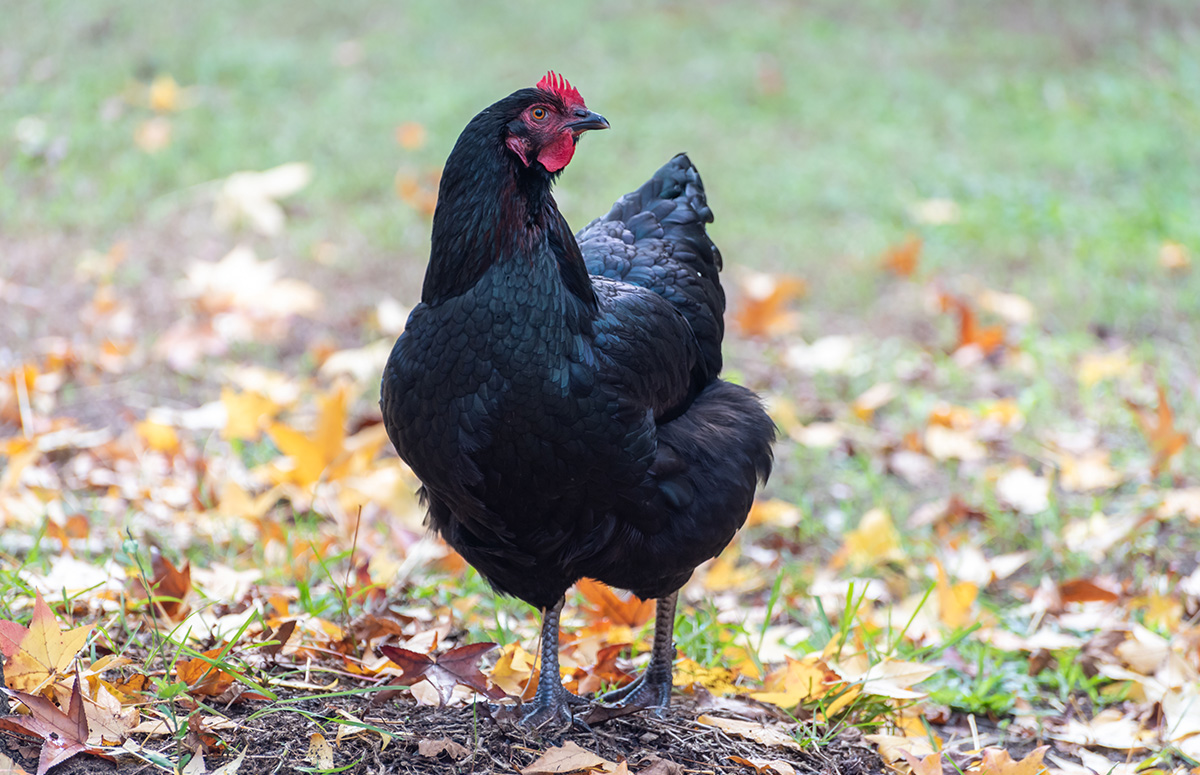
Australorps are usually black, this is also the only plumage color officially recognized in the US, but Australia also recognizes blue and white as colors.
| Eggs | 250-300 eggs per year |
| Egg Color | Light brown |
| Egg Size | Medium to large |
| Weight | 6.5 – 9 lbs |
| Hardiness | Cold |
| Temperament | Friendly and docile |
| Beginner-friendly | Yes |
| Color | Black (US) |
Australorps are very good egg layers, though, laying between 250 and 300 eggs yearly; that’s 5 or 6 per week. This breed usually starts laying at five months of age, although this depends on bird to bird.
Their eggs are medium to large in size and light brown colored. Australorps are cold-hardy birds; they’ll keep on laying during the winter, although egg production can slow down. In other words, they’ll give you a year-round egg supply.
However, Australorps tend to fatten easily when kept in captivity, which can negatively influence their egg-laying skills. When you don’t have a large backyard, an Australorp may not be the breed for you.
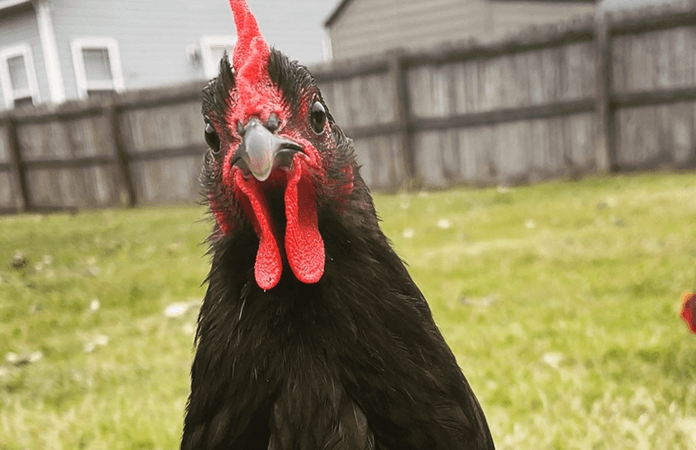
Australorp chickens are a great addition to any backyard flock; they’ll get along with other chickens and are great to have around children. Even the roosters are rarely assertive or aggressive.
7. Jersey Giant
Jersey Giants, as the name reveals, are one of the largest chicken breeds in the world. Some might assume they’re unsuitable as backyard chickens because of their size, but this couldn’t be further from the truth.
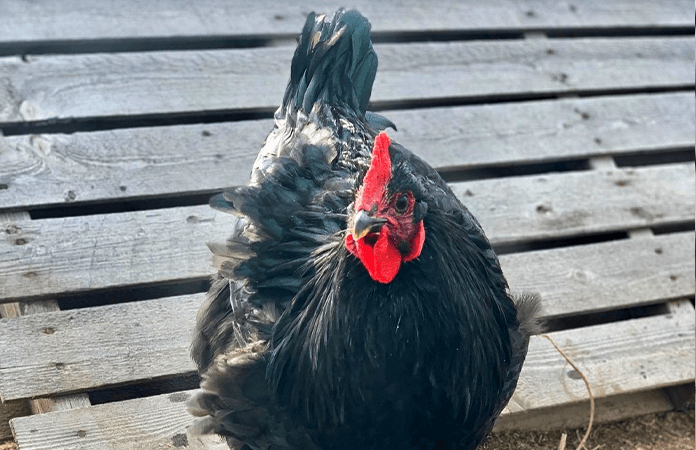
Giants are known for their sweet, docile, and calm nature, making them a fantastic addition to any backyard flock. On top of that, they are great egg-layers too.
| Eggs | 150 – 200 eggs per year |
| Egg Color | Brown |
| Egg Size | Large |
| Weight | 10 – 13 lbs |
| Hardiness | Cold |
| Temperament | Friendly and docile |
| Beginner-friendly | Yes |
| Color | Mostly black, but three recognized colors |
Jersey Giant was developed as a large dual-purpose breed by cross-breeding Black Javas, Black Langshans, and Dark Brahmas. They come in three color varieties: Black, White, and Bleu, but black is the most popular color.
Jersey Giant chickens lay between 150 – 200 eggs per year, between 3 and 5 eggs per week. All eggs are large, and the color varies between cream and brown.
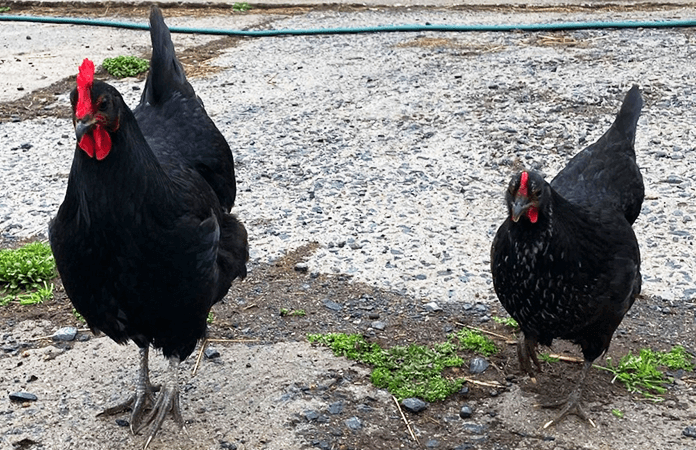
As they look massive, it may come as a surprise Jersey Giants are great pet chickens. They have calm and friendly personalities and are great to keep with small children running around. You can even teach them how to do tricks.
8. White Faced Black Spanish
The White-faced Black Spanish chicken, or in short, Spanish, is an ancient chicken breed with a distinctive appearance. The black feathers with a greenish sheen and oversized white earlobes make them look like a Spanish Don.
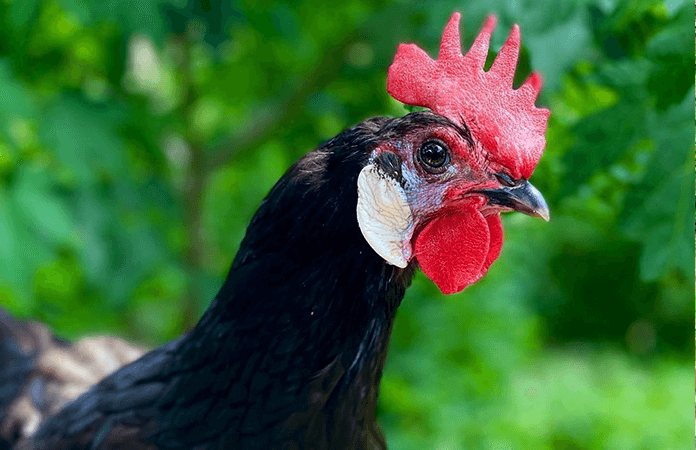
The breed is also called the ‘Clown Faced Chicken’ because the face’s colors resemble a clown’s makeup.
| Eggs | 180 eggs per year |
| Egg Color | White |
| Egg Size | Large |
| Weight | 6.5 – 8 lbs |
| Hardiness | Heat |
| Temperament | Vocal, not aggressive |
| Beginner-friendly | No |
| Color | Greenish-black |
One thing you should know about White-Faced Black Spanish chickens is that they do need more care than most breeds on this list. Being a Mediterranean breed, they don’t thrive in colder climates which is something to keep in mind.
When living in areas with harsh winters, the White-Faced Black Spanish is not the best breed to keep. There are plenty of hardy breeds that’ll do better in extreme weather. They are, however, heat-tolerant birds.
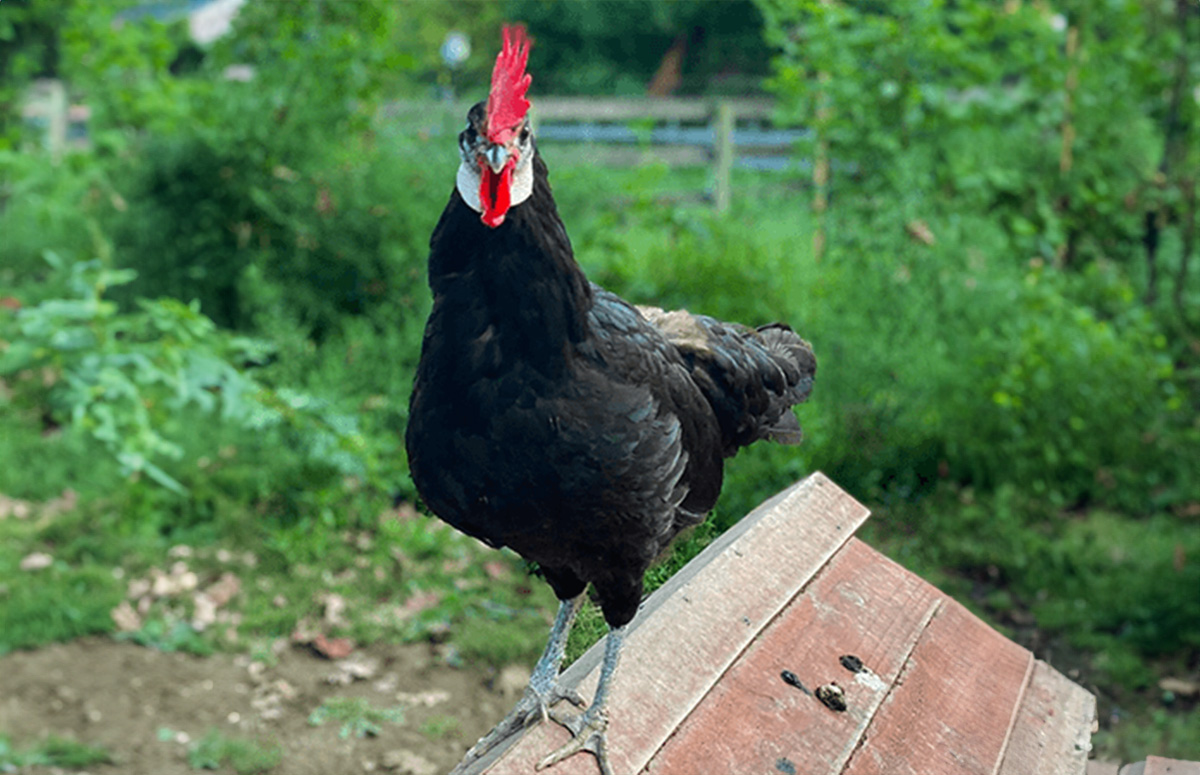
Spanish are decent egg layers that lay up to 180 eggs per year. The eggs are large, around 2.8 oz (80gr), and have a chalk-white color. The breed will start laying at the earliest, at 20-22 weeks.
They’re not the most friendly or cuddliest birds around, but they are never aggressive. A Spanish also requires extra care. However, these fantastic chickens can be an excellent addition to your backyard with enough space and time to devote.
9. Black Silkie
Silkies are widely known because of their fluffy appearance and friendly nature. They are cuddly and sweet and great to have as pet chickens. Even Silkie roosters are known to be less dominant than other roosters.
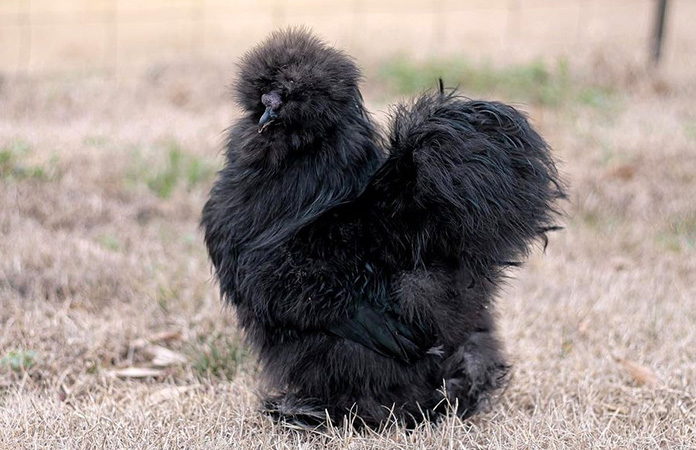
The most popular color in Silkies is white, but black and buff are runners-up.
| Eggs | Three eggs per week, but are often broody |
| Egg Color | Cream to tinted |
| Egg Size | Small |
| Weight | 2 – 3 lbs |
| Hardiness | Cold |
| Temperament | Docile and friendly |
| Beginner-friendly | Yes |
| Color | Varies. Black, white, and buff most popular |
Silkies are a black-skinned chicken breed, like the Ayam Cemani or the Mystic Onyx. Black skin in chickens is far from ordinary; imagine ordering a chicken filet in a restaurant, and the meat you get is black.
This breed looks nothing like a regular chicken breed. Their feathers look like a chick’s down because they lack hooks on the barbicels. Therefore, their feathers can not stick together like normal bird feathers.
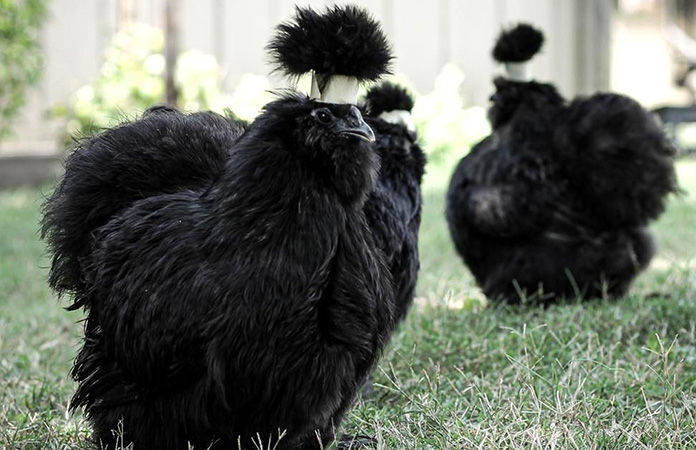
Silkies are ornamental birds, which makes them not specially bred for eggs but mainly for their looks. However, Silkies lay around three eggs per week, resulting in 160 eggs per year. But Silkies are extremely broody chickens, and egg production will always temporarily stop during broodiness.
Therefore, it’s more likely to state that they’ll lay up to 100 eggs annually. All eggs are small in size and cream to tinted in color.
10. Black Araucana
Araucanas are medium-sized birds, not the heaviest or the tallest of the bunch. But they make up for the lack in size with their striking looks and wonderful colored eggs.
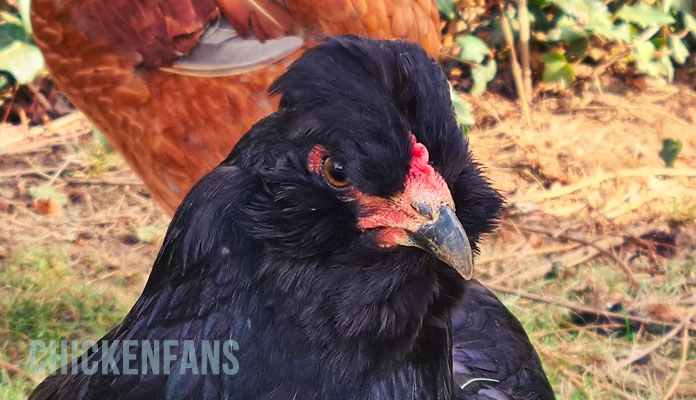
| Eggs | 150 eggs per year |
| Egg Color | Light blue/green |
| Egg Size | Medium |
| Weight | 5.5 – 6.5 lbs |
| Hardiness | Cold |
| Temperament | Friendly, active |
| Beginner-friendly | Yes |
| Color | Varies |
Araucana chickens come in various colors, with black and white being the most popular. Araucana chickens have distinctive ear tufts, a pea comb, and are born rumpless, meaning without a tail.
Araucanas lay up to 3 eggs per week. That’s approximately 150 eggs per year. All eggs are medium-sized and light blue or green in color. The color can vary between (very) light blue or green and khaki.
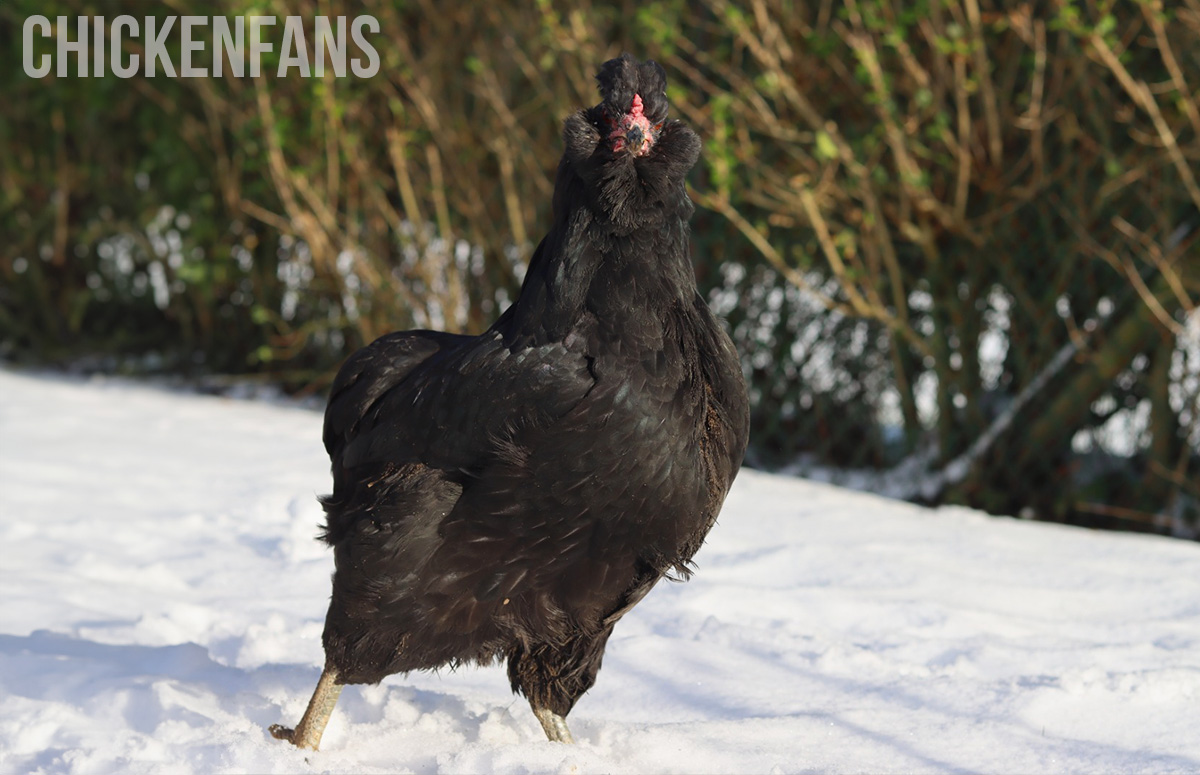
Araucanas are active birds that love roaming around in the garden and need plenty of space to stretch their legs. They can be flighty and have no trouble jumping or flapping over a high fence.
Summary
Black chickens are gaining popularity each day because of their mysterious looks. There are plenty of breeds and chicken types to choose from without spending all the money on a purebred Ayam Cemani.
However, not all black breeds are suitable for every backyard chicken owner. We address all the best black chicken breeds and the reasons why one should or should not consider buying them.
There are hundreds of chicken breeds in the world! If you want to get to know them all, rare or common, heritage or hybrid, go to our ‘All Chicken Breeds & Types Worldwide: List of 500+ Breeds‘.
Related Articles
Top 15 Brown Chicken Breeds: All Beginner-Friendly
10 Fancy Chickens That Go Viral On Social Media
20 Amazing Giant Chicken Breeds
10 Popular Chickens With Colored Eggs
Top 5 Best Egg Layers that Lay Green Eggs






















